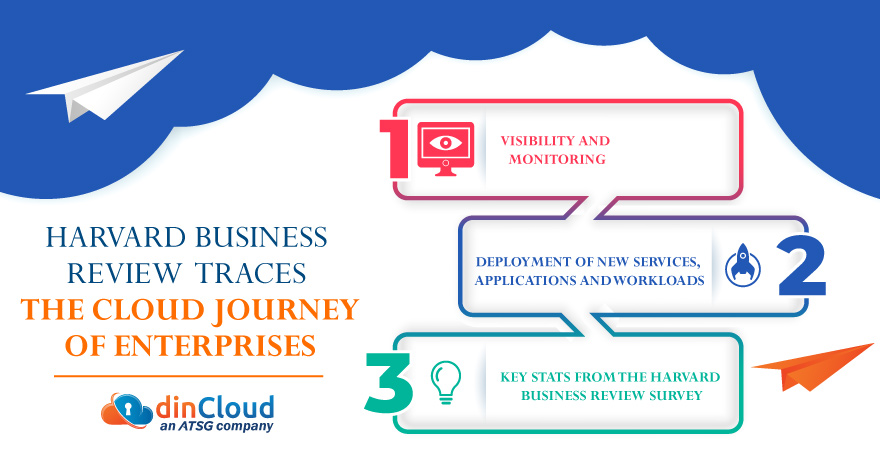In the realm of Cloud Computing services and solutions, the past thirty months have been a roller coaster ride for enterprises. In some cases, the sheer scale and pace of cloud adoption proved overwhelming for IT professionals.
With the rapid adoption of cloud computing services, the following three overarching challenges emerged for enterprises.

Cyber Security
The security of cloud computing services works under the shared responsibility model. While Cloud Service Providers (CSP) have robust security controls in pace, the same can’t be said about all of the deploying enterprises.
Related: How Desktop as a Service (DaaS) Streamlines Hybrid Work?
This is particularly true about the cyber security of hybrid cloud environments, which form the bulk of the post pandemic cloud adoptions. Enterprises are struggling to tie up hybrid cloud security into one cohesive whole, due to the inherent complexities.
Visibility and Monitoring
In the case of hybrid and multi cloud environments, deploying enterprises are having a hard time establishing across the board visibility and monitoring. While both of these are available within each environment individually, but not in the form of a consolidated whole.
Deployment of New Services, Applications and Workloads
Moving over to the Cloud, regardless of the deployment model, is just one part of the overall digital transformation puzzle. In order to reap the true benefits of Cloud Computing, enterprises need to be able to successfully deploy new services, apps and workloads.
This challenge is two dimensional, the first being the inability of enterprises to “lift and shift” their legacy workloads to the Cloud, as such. The other challenge is integrating cloud native apps and workloads seamlessly with the existing enterprise processes.
Now that we have covered the major challenges that enterprises are facing in their cloud journeys, let us discuss the highlights of a recent survey conducted by the Harvard Business Review Analytic Services. The sample size comprised of three hundred IT executives.
Related: The Evolution of Digital Technologies in 2022; thru Deloitte’s Lens
Key Stats from the Harvard Business Review Survey
67% of the respondents said they accelerated their move to Cloud Computing, as a direct response to the Covid-19 pandemic. Till 2020, the first year of this global crisis, this ratio stood at a still healthy 56% of the surveyed enterprises and IT executives.
Another 65% of the respondents were confident that as much as 60% of their overall workloads, processes, data and applications will be residing in the Cloud within the next two years, alluding to a further uptick in cloud adoptions.
The overwhelming majority, 85% to be precise, said that within the next two years, 40% of their existing workloads and processes would have made their way to the Cloud. 62% of the IT executives said they are finding it difficult to cope with the sheer pace of transition.
Related: Why & How are Enterprises Moving towards Green IT in 2022?
A similar 85% of the respondents said they had currently deployed hybrid cloud environments. The overwhelming 88% of the respondents had plans to continue with their existing hybrid cloud deployment models, due to the control, agility and flexibility.
Here are a few more numbers to crunch from the Harvard Business School survey:-
- 45% of the surveyed IT professionals directly cited the lack of talent that could manage cloud environments for the deploying enterprises.
- Another 34% of the respondents found the integration of their legacy workloads and data with the Cloud, as an imminent challenge.
- 31% of the surveyed IT professionals pointed out towards the lack of end to end visibility and monitoring across their on-premise as well as cloud environments.
- A small ratio, 23% to be precise, of the respondents highlighted towards more work and efforts due to ill-planned transitions to cloud environments.
Related: How to Navigate Cloud Security in 2022 – The Balanced Way?
Conclusion
Towards the end of the survey, the consensus view is that only the deploying enterprises are in the best position to overcome these challenges, most of which are otherwise internal to them.
Although leading Cloud Service Providers (CSP) like dinCloud extend their full support and expertise to deploying enterprises, but all this support is limited to the cloud environment itself. How a cloud service gels with the legacy infrastructure is an in-house matter.
Most of the challenges highlighted by IT executives in this survey can also be alleviated by engaging Managed Service Providers (MSP) with the right experience and skillset. Some CSPs also offer managed services as a value added feature, dinCloud included.
The one key takeaway from this elaborate Harvard Business School survey is that Hybrid Cloud will continue to be the go-to option for most enterprises, at least over the next couple years or so.
Contact dinCloud, an ATSG company, for a wide range of Cloud Computing solutions as well as services that are reliable, secure and cost efficient.


